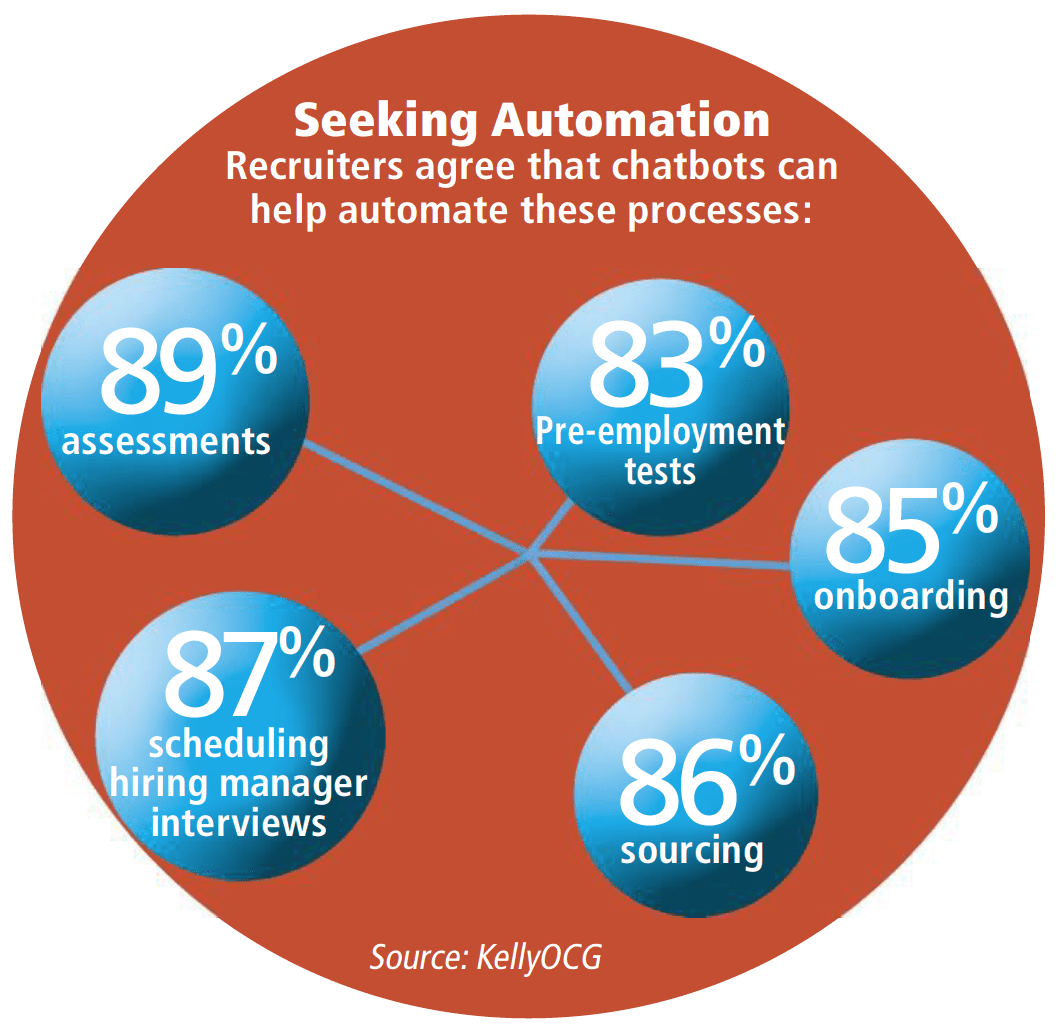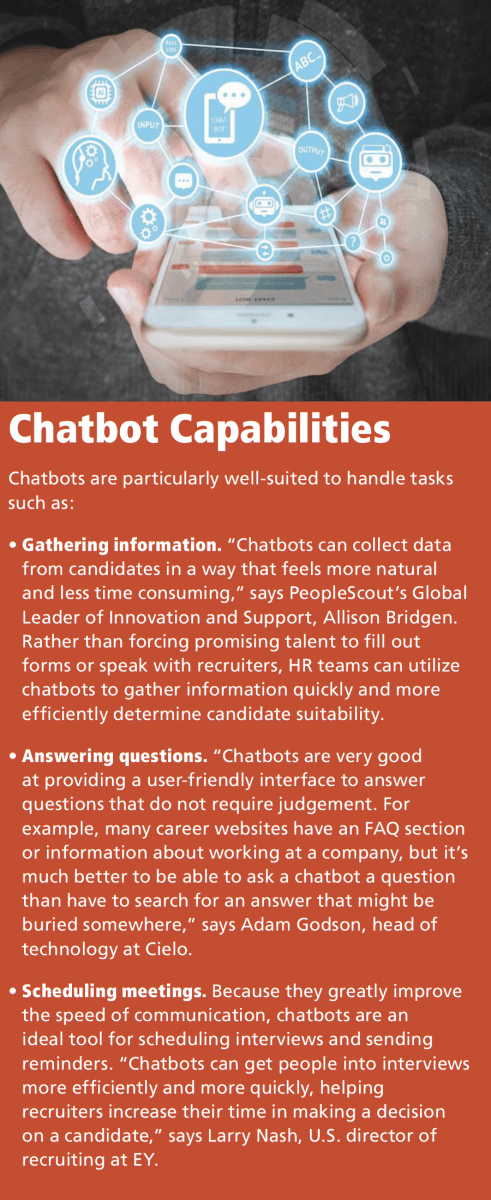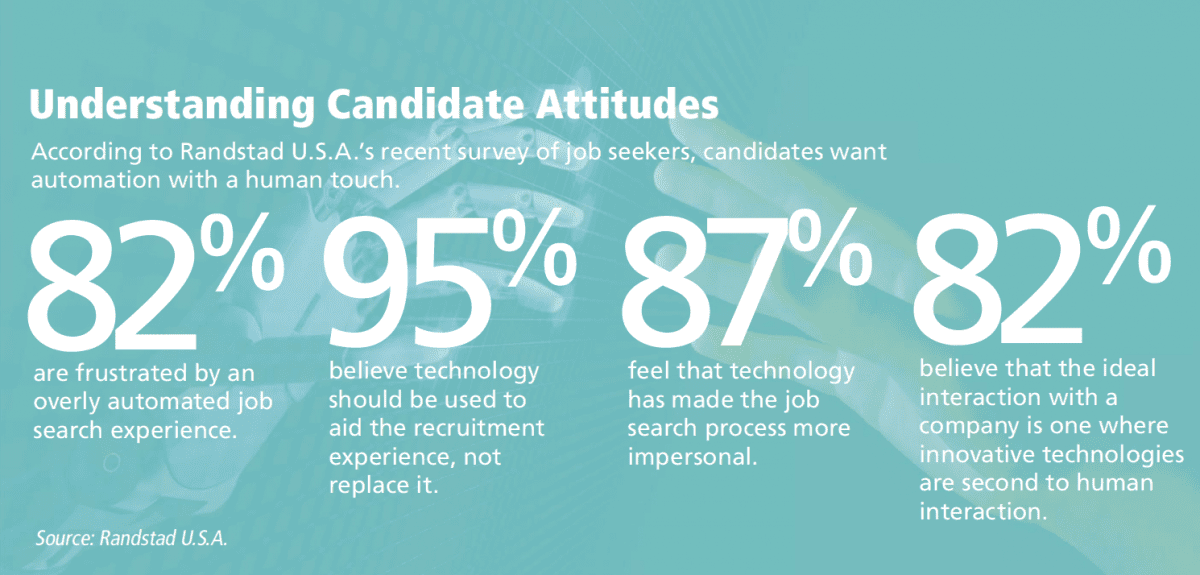Artificial intelligence has the potential to improve speed to hire, quality of hire, and candidate experience.
By Marta Chmielowicz
Chatbot technology is not new. In 2001, more than 30 million people were chatting with SmarterChild on AOL Instant Messenger, and now, chatbots are everywhere. Want to order pizza, see next week’s weather forecast, or get some personal shopping recommendations? There’s a bot for that.
Due to rapid advancement in machine learning and natural language processing, chatbots have not only captured the attention of consumer-facing brands, but are also beginning to infiltrate the business sector. Although they have primarily been utilized in customer service, this technology’s capabilities have broadened beyond support and now offer many opportunities to assist the HR function.
“People have grown more comfortable communicating with chatbots, virtual assistants, and other types of AIenabled technology,” says Allison Bridgen, global leader of innovation and support at PeopleScout. “In fact, many people prefer talking to chatbots in certain situations. As these technologies become more popular, it also drives the increased use of chatbots in talent acquisition.”
Companies that take advantage of these technological developments can gain a competitive advantage. “Since people spend more time on their phones than on their computers, HR teams are realizing that if they want to win the war for talent, their candidate and employee conversations need to be over text messaging. By using chatbots, they become on-demand resources available 24/7,” says Erik Kostelnik, founder and CEO of TextRecruit.

And with 80 percent of talent acquisition professionals reporting that many core aspects of the recruitment process can be automated, according to KellyOCG’s Digital Recruiting: Disruption by Design, and not Default report, it is no surprise that 2018 is projected to be the year of the chatbot.
Adding Business Value
Thanks to a highly competitive job market, rapid technological advancement, and changing job candidate priorities, recruiters today are facing several unique challenges -and chatbots are poised to help.
“HR chatbots have evolved out of increased competition among employers to hire, engage, and retain the best talent. Candidates and employees are looking for speed and convenience when communicating with HR, and if you can’t provide that you’re going to risk losing your best people,” says Kostelnik.
Chatbots can help recruiters overcome four major hiring challenges:
- Identifying and attracting talent for difficult-to-fill roles;
- Managing a high volume of applicants;
- Maximizing hiring efficiency; and
- Creating an attractive employer brand.
By automating routine and time-consuming processes, chatbots improve hiring efficiency and free up recruiters’ time and resources, allowing them to focus on their most important job -connecting with people. In doing so, they also enhance candidate experience and, as a result, employer brand.
“Chatbots can help recruiters gain more time in their days by taking on some of the administrative tasks that recruiters handle. As this technology continues to evolve, it enables recruiters to spend more time on higher-value activities in a consultative talent advisor role and engaging to reach passive candidates,” says Bridgen.
In particular, this automated technology excels at performing standardized, repetitive tasks on a large scale. “Tasks like answering questions, asking screening questions, setting appointments, and sending reminders are where recruiters need help from chatbots today,” says TextRecruit’s Kostelnik. “After a hiring decision has been made, HR chatbots can assist with onboarding by walking employees through start dates, answering frequently asked questions, sending reminders about benefits enrollment, and ensuring onboarding paperwork is complete.”
In addition, they provide a convenient on-demand resource for candidates, improving the quality and speed of the application process. “Through chatbots, candidates can ask questions and receive answers from wherever they are, whenever is most convenient for them,” says Bridgen.
Chatbots also reduce the frustration candidates face when seeking jobs that match their interests and skillsets by asking pre-screening questions and automatically parsing resumes. This improves the candidate experience and reduces the number of unqualified applicants.
If done well, the use of this technology can have a profound impact on employer brand, painting the organization as an employer of choice. “Integrating chatbots extends your employment brand,” says Larry Nash, U.S. director of recruiting at EY. “Candidates see your organization as being innovative and doing new things that enable the candidate experience, and assume that’s probably a reflection of the culture the organization has.”
Adopting a Chatbot
Although chatbots have the potential to streamline screening, recruitment, and onboarding procedures, effective implementation is key. HR professionals should take into consideration the following five best practices to ensure successful outcomes:
1. Evaluate the business and define clear goals. The first step for companies looking to adopt chatbot technology is taking an assessment of the talent acquisition function and identifying areas of opportunity.
“You’ve got to look throughout the recruitment process and first see where there’s an opportunity to use a chatbot that’s going to solve a challenge -whether it’s providing a more exceptional experience, moving talent quicker, or providing a service that doesn’t exist yet,” says EY’s Nash.
In addition to evaluating specific hiring challenges, this audit should also include an assessment of the organization’s corporate culture and digital readiness. This ensures that companies choose a product that matches their business needs and current capabilities.
2. Identify the right tool. Once business needs are defined, companies must tackle the task of choosing the right chatbot for their organization. According to Nash, it is important that they ask themselves these specific questions:
- Who will be using this technology?
- How will users interface with the chatbot?
- Does it need to be accessible on a mobile device?
- Does the chatbot need machine learning capabilities so that it can constantly improve?
- What aspects of the recruitment process should the chatbot enhance?
- How much time do recruiters currently spend on the functions that will be taken over?
- Is the HR team prepared to deal with issues that may arise?
“Once you answer these questions, then you can figure out what type of chatbot is needed and work with a variety of vendors that can help provide the solution that a company needs,” Nash says.
For companies that fail to successfully identify the appropriate chatbot for their overall talent acquisition strategy, the consequences can be problematic. “Employers should ensure they’re using a high-quality, effective chatbot technology platform. If the chatbot struggles to answer questions or respond appropriately to candidates, that can negatively impact the employer brand more than having a candidate wait for an answer from a recruiter,” says PeopleScout’s Bridgen.
3. Ensure the chatbot is integrated. “Chatbots should be part of an end-to-end technology solution, integrated throughout the entire application process in order to be the most effective in communicating with candidates,” Bridgen explains.
By integrating chatbots into a broader strategy, HR teams can access data across their organization’s talent acquisition and management platforms to generate insights and improve functionality.
“Many chatbots can integrate with ATS or CRM software in order to provide deeper information to candidates,” says Adam Godson, Cielo‘s head of technology. For example, if candidates are looking to find the status of their applications or to reschedule an interview, a platform that is integrated would likely have access to the right data to answer those questions.
4. Train the chatbot and measure its results. Once a chatbot is in place, HR teams should ensure that it is providing a good user experience. “When you get it up and running, the bot needs to continually learn. I don’t think you could just put a bot in place and wipe your hands. You’ve got to constantly tinker with it, make sure that it’s learning from all the questions it receives and responses it provides, and then measure the feedback that people are providing on it. If users are not having a positive experience with it, then you’ve got to change it,” says Nash.
Chatbot performance can be measured in several ways:
- Real-time candidate feedback. “Chatbots can be easily programmed to gather experience metrics at the end of a chat or use text sentiment analysis to gauge candidate happiness,” says Godson.
- Post-hire surveys. “Many of our customers use posthire surveys to evaluate how text messaging, live chat, and chatbots impacted the candidate experience,” says Kostelnik.
- Measured outcomes. “Chatbot effectiveness can be measured by time-to-hire, average response time, and candidate response rates,” Kostelnik adds. In addition, organizations can evaluate chatbot performance by measuring the amount of time that they save recruiters.
5. Maintain a balance. Although chatbots can play an important role in automating and enhancing certain parts of the recruitment process, organizations need to continue providing human interaction. “Chatbots alone won’t address all of the challenges facing recruiters today,” says Nash. “While there’s the ability to make things more efficient or give information more quickly, at the end of the day, the human interaction will continue to be the most important part of the interviewing and assessment process.”
According to a recent study by Randstad U.S.A., while most job seekers find value in technology, 82 percent are often frustrated by an overly automated job search experience. In fact, 95 percent of respondents believe that technology should be used to aid the recruitment experience, not replace it.
“Candidates prefer an experience that has the right mix of technology and real human interaction with a recruiter. While a chatbot can automate some of the hiring processes, recruiters need to continue to play a major role in engaging with candidates, especially through stages like the offer management process,” says Bridgen.
















